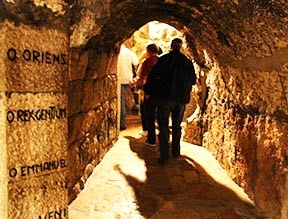![]() |
| Mass at St, Catherine's Church, Bethlehem |
We spent the day today in Bethlehem. Our journey into the mystery of Christ's birth of Mary in this very place began with the celebration of Christmas Midnight Mass (special permission is given in the Holy Land to celebrate the proper liturgical feast commemorated by the holy site being visited when on pilgrimage). At midnight (Edmonton time) we gathered in the Church of St. Catherine of Alexandria for this solemn Eucharist. This parish church is adjacent to the Church of the Nativity, which is built over the grotto marking the place of the Lord's birth. We sang Christmas carols as we gave thanks to the Father for the gift of the birth of the Prince of Peace.
 |
Graffitti inside the security
wall around Bethlehem |
At the same time we were painfully aware of the lack of peace surrounding us. Any pilgrim to Bethlehem cannot fail to observe and feel the jarring contrast between the meaning of the nativity of our Lord and the present-day reality of Bethlehem and Jerusalem. On our short eight kilometre ride from our hotel in Jerusalem to the Manger Square in Jerusalem, we encountered the sad reality of the huge concrete wall erected by the Israeli authorities as a security perimeter around the Palestinian Territories. This is an area marked by division, symbolized in dramatic fashion by that wall. The separations that drive people apart are both political and religious, operative at multiple levels. What is common to them all is their source: divisions within the human heart. We set up physical, political and religious walls because we have first erected within our hearts barriers of mistrust, fear, and bitterness. It is to heal our divisions at that level, the level of the heart, that Jesus Christ was born for us. Thus did we find ourselves praying during our Christmas celebration that all hearts, including our own, would be healed of their fissures by the transformative power of God's mercy, revealed and active in the One born of Mary at Bethlehem.
 |
| St. Catherine's Church |
Following this Eucharist, we visited the ancient grottos beneath that same church. At the cave where Saint Jerome lived for thirty-eight years in the fourth century as he translated the Bible into Latin, we prayed for that same sacred Word to take deep root in our hearts. Standing near the catacombs of the Holy Innocents, the children slaughtered by order of an insane King Herod, we prayed for the holy innocents of our own day, whose lives are ended through the insanity of abortion.
 |
| Praying at the site where Jesus was born |
From there we moved to the Church of the Nativity and the sacred grotto where the birth of our Lord occurred. After we each knelt individually to reverence this most holy ground, we assembled together in this wondrous space and sang O Holy Night in both English and French. More than a few tears and sniffles accompanied our singing. The awareness of where we actually were was very moving, to say the least!
 |
| The Shepherds' Fields |
Then on to Shepherds' Field and Grotto a few kilometres east of Bethlehem. This site contains caves identified by tradition as the place where shepherds were startled by the angels' annunciation of the birth of the Saviour. After singing another carol there in one of the caves, we visited a church built on the site (Sanctuary of the Holy Angels) and funded by donations from Canadians.
 |
| Graffitti inside the security wall around Bethlehem |
After that, lunch and an opportunity to do some shopping in Bethlehem. As we left the city we had to pass, once again, through a checkpoint at a gate in that security wall. Thus did our day end as it began: with prayers for a healing of divisions and a lasting peace here in this land we call holy.
 |
| Manger Square |
 |
| Church of the Nativity, Bethlehem |
 |
| Visiting sites beneath Church of the Nativity |
 |
| Time for reflection in a cave at Shepherds' Fields |
 |
| Nativity fresco at Shepherds' Fields church |
 |
| Altar at the Canadian-built church at Shepherds' Fields |










